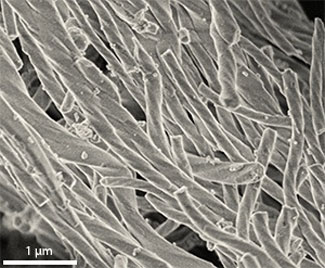| Jul 04, 2011 |
Precise helicity control in chiral mesoporous materials could lead to more efficient pharmaceutical production
|
|
(Nanowerk News) Mesoporous materials have nanoscale pores that endow the materials with a remarkably large ratio of surface area to mass. The pores, typically 2–50 nm in size, are on a scale that allows small organic molecules to enter and react with the inner pore surfaces. This makes the materials useful for applications in catalysis and absorption.
|
|
The preparation of mesoporous materials with chiral pores is of particular interest for the production of pharmaceuticals. A chiral structure has a left- or right-handed helical twist, and many naturally occurring and synthetic compounds come in left- and right-handed chiral forms, known as enantiomers. Unfortunately, it is often very difficult to separate the two forms chemically, and getting the precise helical structure needed to isolate a certain enantiomer physically remains a challenge. Takashi Tatsumi and co-workers from the Tokyo Institute of Technology and Yokohama National University in Japan have now reported the preparation of chiral mesoporous materials with perfect control of helicity ("Preparation of Chiral Mesoporous Materials with Helicity Perfectly Controlled").
|
 |
| A scanning electron microscopy image of a chiral mesoporous material.
|
|
Mesoporous materials are generally prepared by templating methods using assemblies of surfactants as a mold. Tatsumi and his co-workers turned to some naturally occurring amino acids to derive chiral surfactants that would allow them to prepare a chiral mesoporous organosilica material.
|
|
"Using chiral surfactants as the template, we have previously shown that we can make chiral mesoporous materials with preference for one type of helicity," explains Tatsumi. "Small changes in the reaction conditions, however, could change the morphology of the final material, so it has not been possible to control the helicity completely."
|
|
The preparation requires careful pH control, and Tatsumi and his co-workers have found that using arginine — a weakly basic amino acid — gives much greater control over the final morphology of the material. When combined with a chiral surfactant, the researchers were able to obtain mesoporous organosilica materials with perfect helicity control (see image).
|
|
"At this time, we know that several factors, including the chirality of the surfactant and arginine additive, and the source of the organosilane reactant, all contribute to the morphology and chirality of the final product," says Tatsumi. "We are continuing to investigate the preparation of these useful materials, which we ultimately hope will be applied in the production of enantiomerically pure pharmaceuticals and other chemicals."
|

